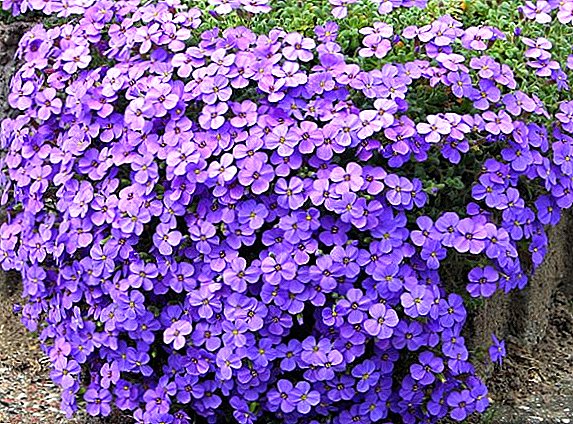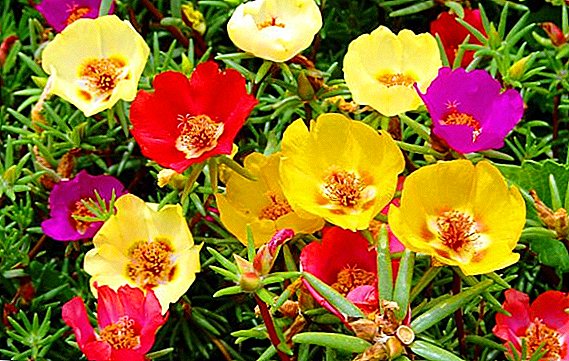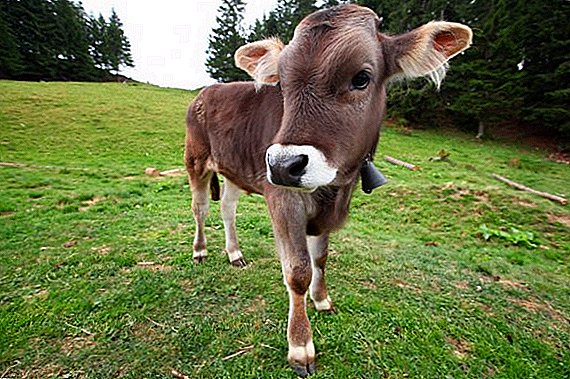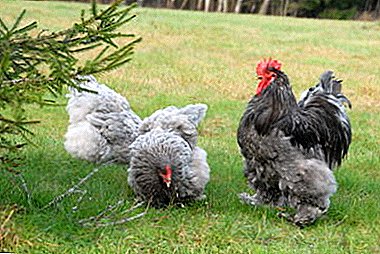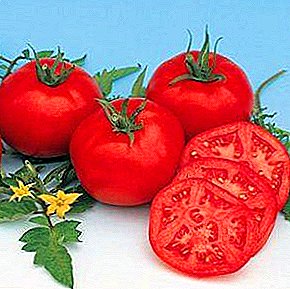
Compact bushes of tomato variety Moskvich - a real find for residents of the regions with a short summer.
Early ripe tomatoes can be harvested at the beginning of summer, they have a pleasant taste, high content of healthy substances. The variety is undemanding to care and easily put up with the vagaries of the weather.
Read in our article a detailed description of this interesting variety, get acquainted with its characteristics and cultivation features. We will also tell you all about disease and pest resistance.
Tomato "Moskvich": description of the variety
| Grade name | Moskvich |
| general description | Early ripe determinant high-yielding grade |
| Originator | Russia |
| Ripening | 90-95 days |
| The form | Round or flat rounded, with slight ribbing at the stem |
| Colour | Red |
| Average tomato mass | 60-80 grams |
| Application | Dining room |
| Yield varieties | 10-14 kg per square meter |
| Features of growing | Agrotechnika standard |
| Disease resistance | Disease resistant |
 Moskvich - high-yielding early ripe grade. Bush determinant, compact, stem-type, with a moderate formation of green mass. About indeterminantny grades read here. Corrugated leaves, medium-sized, dark green. The fruits ripen with brushes of 4-6 pieces. The yield is high, from 1 square. meters of planting can be collected 10-14 kg of selected tomatoes.
Moskvich - high-yielding early ripe grade. Bush determinant, compact, stem-type, with a moderate formation of green mass. About indeterminantny grades read here. Corrugated leaves, medium-sized, dark green. The fruits ripen with brushes of 4-6 pieces. The yield is high, from 1 square. meters of planting can be collected 10-14 kg of selected tomatoes.
Among the main advantages of the variety:
- tasty, smooth and beautiful fruits;
- good yield;
- the universality of the use of fruits;
- cold resistance;
- unpretentiousness to the conditions of detention.
You can compare the yield of a variety with others in the table below:
| Grade name | Yield |
| Moskvich | 10-14 kg per square meter |
| Frost | 18-24 kg per square meter |
| Union 8 | 15-19 kg per square meter |
| Balcony miracle | 2 kg from a bush |
| Red dome | 17 kg per square meter |
| Blagovest F1 | 16-17 kg per square meter |
| King early | 12-15 kg per square meter |
| Nikola | 8 kg per square meter |
| Ob domes | 4-6 kg from a bush |
| King of Beauty | 5.5-7 kg from a bush |
| Pink meaty | 5-6 kg per square meter |
The peculiarities of the variety include the demands on the nutritional value of the soil.
Fruit Description:
- Tomatoes are medium in size, weighing from 60 to 80 g.
- The form is round or flat-round, with a slight ribbing at the stem.
- In the technical ripeness phase, the tomatoes are brown-green with a darker spot near the stem.
- Ripe tomatoes become saturated red.
- The skin is dense, but not hard, the flesh is juicy, fleshy, with a small amount of seeds.
- The amount of solids in the juice reaches 6%, sugars - up to 3%.
- The taste of ripe fruit is intense, sweetish, not watery.
To compare the weight of fruit varieties with other data in the table:
| Grade name | Fruit weight |
| Moskvich | 60-80 grams |
| Japanese black truffle | 120-200 grams |
| Frost | 50-200 grams |
| Octopus F1 | 150 grams |
| Red cheeks | 100g |
| Pink meaty | 350 grams |
| Red dome | 150-200 grams |
| Honey Cream | 60-70 grams |
| Siberian early | 60-110 grams |
| Domes of Russia | 500 grams |
| Sugar cream | 20-25 grams |
Tomatoes are tasty fresh, suitable for salads, hot dishes, soups, sauces, juices. Small fruits with thin, but dense skin can be salted, pickled, included in vegetable mixes.
 Read also on our website: How to care for early-season varieties? How to get the best harvest in the open field?
Read also on our website: How to care for early-season varieties? How to get the best harvest in the open field?How to grow delicious tomatoes all year round in greenhouses? What varieties have good immunity and high yield?
A photo
We suggest you to get acquainted with the photos of the tomato variety "Moskvich":


Features of growing
 The variety of tomato Moskvich is bred by Russian breeders, zoned for the regions of Siberia, the Volga region, North-Western and Central regions. Recommended cultivation in open ground or under film. Harvested fruits are well stored, transportation is possible. Green tomatoes are ripened successfully at room temperature.
The variety of tomato Moskvich is bred by Russian breeders, zoned for the regions of Siberia, the Volga region, North-Western and Central regions. Recommended cultivation in open ground or under film. Harvested fruits are well stored, transportation is possible. Green tomatoes are ripened successfully at room temperature.
Tomato varieties Moskvich, like other early tomatoes, more convenient to grow seedling way. Before sowing, seeds are soaked in a growth stimulator that provides excellent germination. The soil is composed of a mixture of garden soil with peat or humus. Seeds are sown with a depth of 1.5-2 cm, sprinkled with peat, sprayed with water. For successful germination need a temperature of 23 to 25 degrees. After the emergence of shoots it is reduced, and the containers with seedlings are placed on a bright light.
Young tomatoes need a long light day and moderate watering with warm settled water. When the first true leaves unfold on the seedlings, they swoop and then feed them with a liquid complex fertilizer. Plants intended for planting on open beds should be hardened, bringing to a veranda or balcony for several hours.
Transplantation into the ground begins in the second half of May and early June. The soil should warm up, at first young plants can be covered with foil. Bushes are planted at a distance of 30-40 cm from each other, with a row spacing of at least 60 cm. It is not necessary to tie or form them; for better insolation, the lower leaves can be removed.
Water tomatoes abundantly, but not often, using only warm water. Every 2 weeks the plants are fed complex fertilizer with a predominance of phosphorus and potassium.
It is very important to choose the right soil, both for planting seedlings and for adult plants in the greenhouse. To understand this article will help about the types of soil for tomatoes. You will also find on our website information on how to prepare the land for tomatoes yourself.
Read more about how to fertilize tomatoes and how.:
- Organic, mineral, phosphorus, complex, ready-made fertilizers.
- TOP best.
- Yeast, iodine, hydrogen peroxide, ammonia, ash, boric acid.
- Top dressings for seedlings, foliar and when picking.
Diseases and pests
Early ripe tomato varieties are usually resistant to diseases, Moskvich is not an exception. The plant is not susceptible to fusarium, verticillosis, Alternaria and other typical nightshade diseases in greenhouses. Before planting, it is recommended to disinfect the soil with a hot solution of potassium permanganate. You can use other methods of dealing with diseases.
Prevent basal or gray rot can frequent loosening of the soil, removal of weeds. The soil can be ground peat. It is necessary to use non-toxic bio-drugs, such as phytosporin, to prevent the occurrence of late blight. Read also about other ways of protection against phytophtoras and varieties resistant to it.
Insect pests can threaten tomatoes: aphids, spider mites, thrips, Colorado beetles, slugs. To combat them, there are many proven methods:
- How to get rid of spider mites.
- What to do if aphids and thrips are bred in the garden.
- Fighting with the Colorado potato beetle and its larvae.
- Reliable ways to get rid of slugs.
Tomatoes variety "Moskvich" feel great in the open field, they are less prone to disease and forgive small errors in agricultural technology. The reward for the work will be delicious tomatoes, the first fruits can be plucked in June.
In the table below you will find links to varieties of tomatoes ripening at different times:
| Superearly | Mid-season | Medium early |
| Leopold | Nikola | Supermodel |
| Schelkovsky early | Demidov | Budenovka |
| President 2 | Persimmon | F1 major |
| Liana Pink | Honey and sugar | Cardinal |
| Locomotive | Pudovik | Bear Paw |
| Sanka | Rosemary pound | King Penguin |
| The miracle of cinnamon | King of beauty | Emerald Apple |


